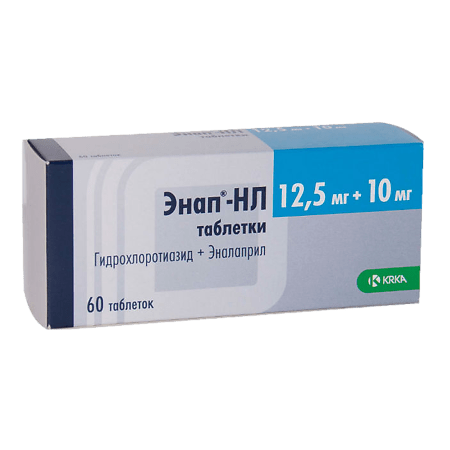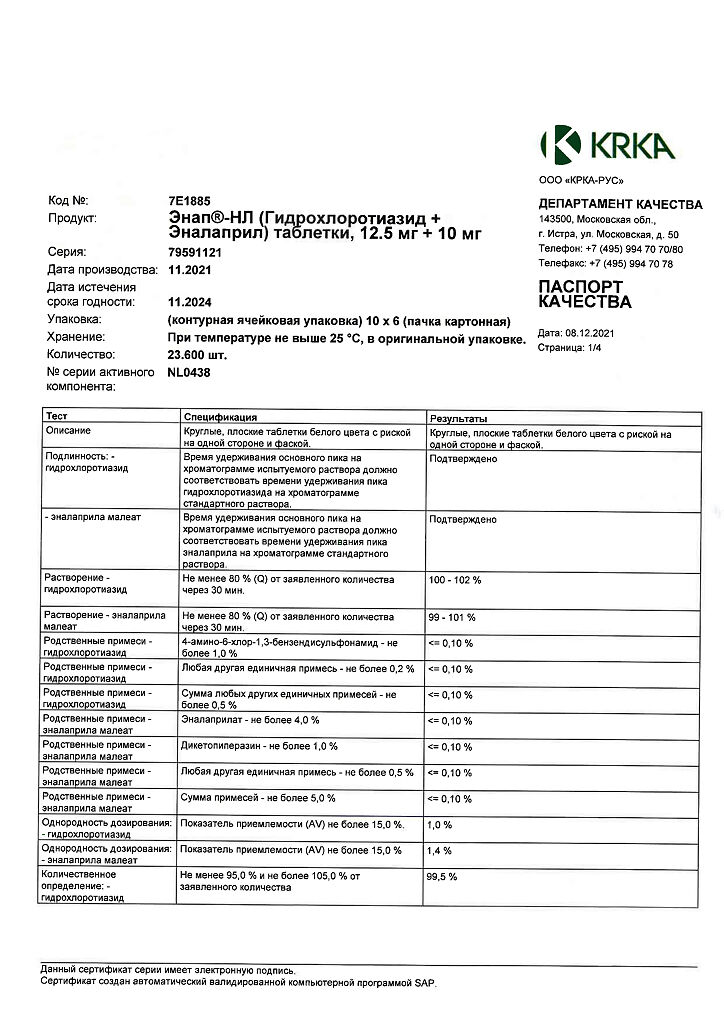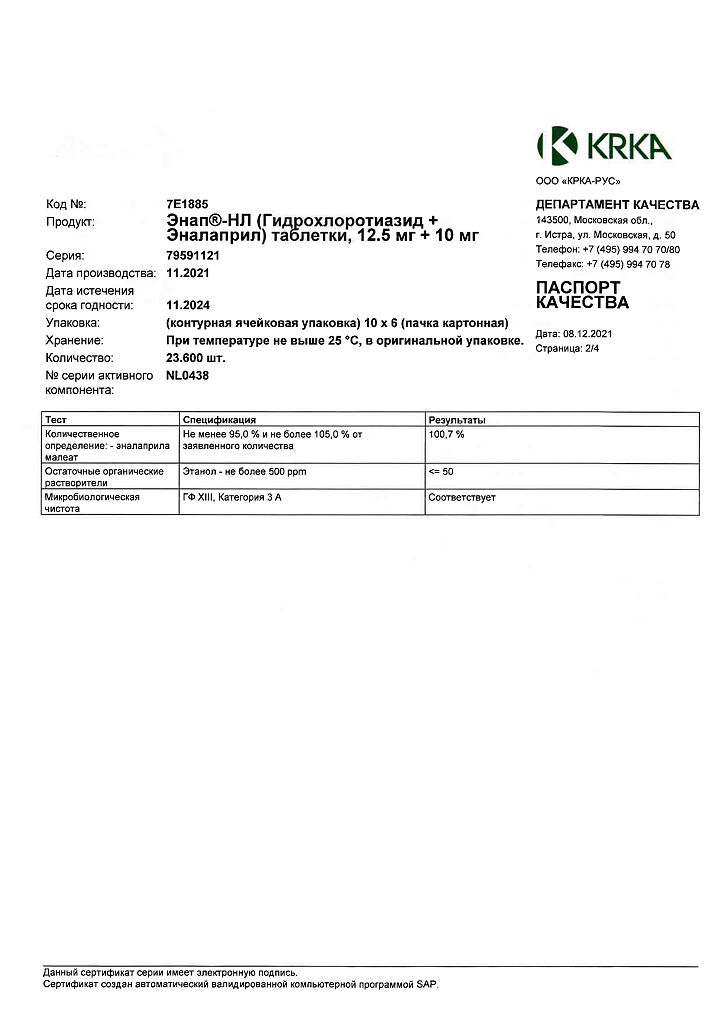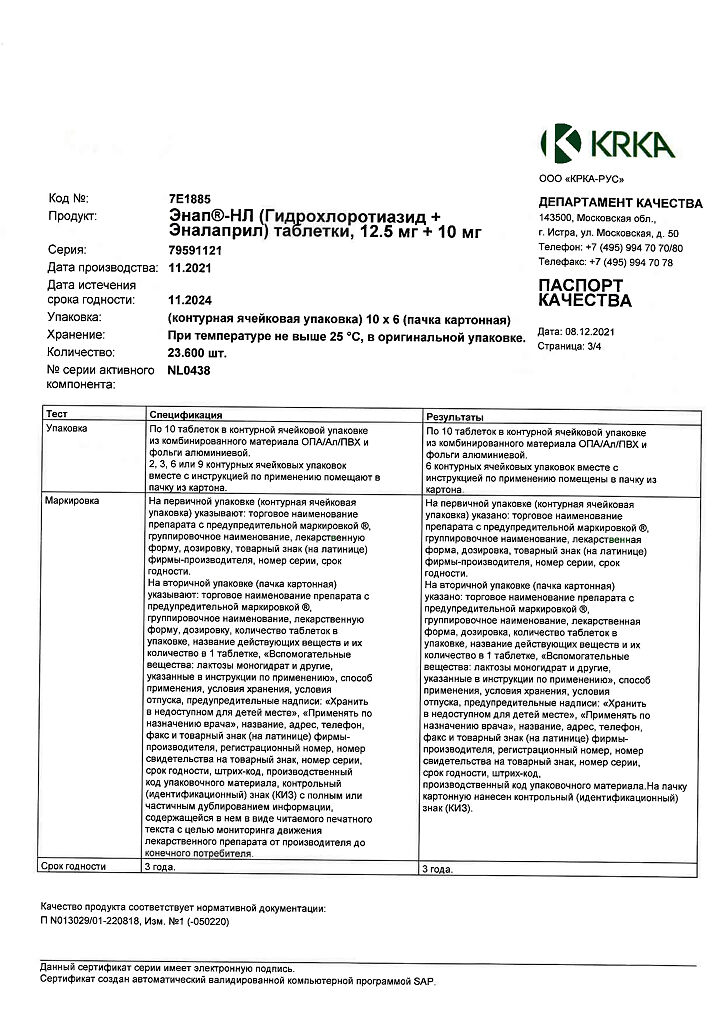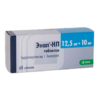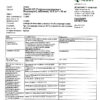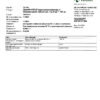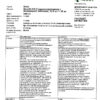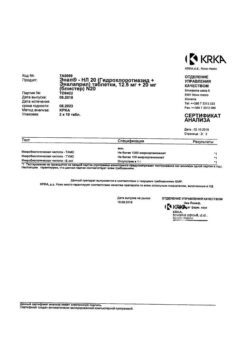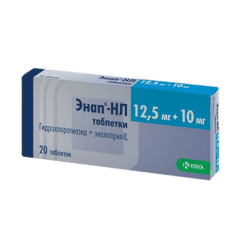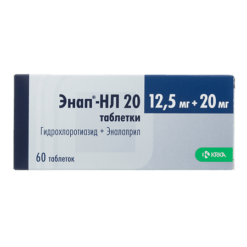No products in the cart.
Enap-NL, tablets 12.5mg+10 mg 60 pcs
€19.88 €16.57
Description
A combination drug, the action of which is due to the properties of its constituent components.
Enalapril is an ACE inhibitor and is a prodrug: its hydrolysis produces enalaprilate, which inhibits ACE.
Hydrochlorothiazide is a thiazide diuretic. It acts at the level of the distal renal tubules, increasing the excretion of sodium and chlorine ions.
In the beginning of treatment with hydrochlorothiazide, the volume of fluid in blood vessels is reduced as a result of increased sodium and fluid excretion, which leads to a decrease in BP and cardiac output.
As a consequence of hyponatremia and decreased body fluid, the RAAS is activated. Reactive increase of angiotensin II concentration partially limits BP reduction. If therapy is continued, the hypotensive effect of hydrochlorothiazide is based on the reduction of RAS. The result of activation of renin-angiotensin-aldosterone system is metabolic effects on electrolyte balance of blood, uric acid, glucose and lipids, which partially neutralizes the effectiveness of antihypertensive treatment.
Despite effective BP reduction, thiazide diuretics do not reduce structural changes in the heart and vessels. Enalapril enhances the antihypertensive effect: it inhibits the RAAS, i.e. angiotensin II production and its effects. Additionally, it reduces the production of aldosterone and enhances the effects of bradykinin and the release of prostaglandins. Since it often has its own diuretic effect, this may increase the effect of hydrochlorothiazide.
Enalapril reduces pre- and postload, which unloads the left ventricle, reduces regression of hypertrophy and collagen overgrowth, and prevents myocardial cell damage. As a result, the heart rhythm slows down and the load on the heart (in chronic heart failure) decreases, coronary blood flow improves and oxygen consumption by cardiomyocytes decreases.
In this way, the sensitivity of the heart to ischemia is reduced, and the number of dangerous ventricular arrhythmias is reduced. It has a favorable effect on the cerebral blood flow in patients with arterial hypertension and chronic cardiovascular diseases. It prevents the development of glomerulosclerosis, maintains and improves kidney function and slows down the course of chronic kidney disease even in patients who have not yet developed arterial hypertension.
The antihypertensive effect of ACE inhibitors is known to be greater in patients with hyponatremia, hypovolemia and elevated serum renin levels, whereas the effect of hydrochlorothiazide is independent of serum renin levels.
Hence, concomitant administration of enalapril and hydrochlorothiazide has an additional antihypertensive effect. In addition, enalapril prevents or attenuates the metabolic effects of diuretic therapy and has a favorable effect on structural changes in the heart and vessels.
The simultaneous administration of ACE inhibitor and hydrochlorothiazide is used when each drug separately is not sufficiently effective or monotherapy is performed using maximum doses of the drug, which increases the incidence of adverse effects. This combination allows for a better therapeutic effect with lower doses of enalapril and hydrochlorothiazide and a reduction in the development of adverse events.
The antihypertensive effect of the combination usually lasts for 24 h.
Indications
Indications
Arterial hypertension (patients for whom combination therapy is indicated).
Pharmacological effect
Pharmacological effect
A combined drug, the effect of which is determined by the properties of the components included in its composition.
Enalapril, an ACE inhibitor, is a prodrug: as a result of its hydrolysis, enalaprilat is formed, which inhibits ACE.
Hydrochlorothiazide is a thiazide diuretic. Acts at the level of the distal renal tubules, increasing the excretion of sodium and chloride ions.
At the beginning of treatment with hydrochlorothiazide, the volume of fluid in the vessels decreases as a result of increased excretion of sodium and fluid, which leads to a decrease in blood pressure and a decrease in cardiac output.
Due to hyponatremia and decreased fluid in the body, the RAAS is activated. A reactive increase in angiotensin II concentration partially limits the decrease in blood pressure. With continued therapy, the hypotensive effect of hydrochlorothiazide is based on a decrease in peripheral vascular resistance. Activation of the renin-angiotensin-aldosterone system results in metabolic effects on blood electrolyte balance, uric acid, glucose and lipids, which partially counteract the effectiveness of antihypertensive treatment.
Despite their effective reduction in blood pressure, thiazide diuretics do not reduce structural changes in the heart and blood vessels. Enalapril enhances the antihypertensive effect: inhibits the RAAS, i.e. angiotensin II production and its effects. Additionally, it reduces the production of aldosterone and enhances the effect of bradykinin and the release of prostaglandins. Because it often has its own diuretic effect, which may enhance the effect of hydrochlorothiazide.
Enalapril reduces pre- and afterload, which unloads the left ventricle, reduces regression of hypertrophy and collagen proliferation, and prevents damage to myocardial cells. As a result, the heart rhythm slows down and the load on the heart decreases (in case of chronic heart failure), coronary blood flow improves and oxygen consumption by cardiomyocytes decreases.
Thus, the sensitivity of the heart to ischemia is reduced, and the number of dangerous ventricular arrhythmias is reduced. It has a beneficial effect on cerebral blood flow in patients with arterial hypertension and chronic cardiovascular diseases. Prevents the development of glomerulosclerosis, maintains and improves kidney function and slows down the course of chronic kidney disease, even in those patients who have not yet developed arterial hypertension.
It is known that the antihypertensive effect of ACE inhibitors is greater in patients with hyponatremia, hypovolemia and elevated serum renin levels, while the effect of hydrochlorothiazide is independent of serum renin levels.
Therefore, the simultaneous administration of enalapril and hydrochlorothiazide has an additional antihypertensive effect. In addition, enalapril prevents or reduces the metabolic effects of diuretic therapy and has a beneficial effect on structural changes in the heart and blood vessels.
The simultaneous administration of an ACE inhibitor and hydrochlorothiazide is used when each drug alone is not sufficiently effective or monotherapy is carried out using maximum doses of the drug, which increases the incidence of undesirable effects. This combination allows you to obtain a better therapeutic effect with lower doses of enalapril and hydrochlorothiazide and reduce the development of undesirable effects.
The antihypertensive effect of the combination usually lasts for 24 hours.
Special instructions
Special instructions
Hypotension with all its clinical consequences may occur after the first dose of this combination in patients with severe heart failure and hyponatremia, severe renal failure, hypertension or left ventricular dysfunction and, in particular, in patients who are in a state of hylovolemia as a result of diuretic therapy, salt-free diet, diarrhea, vomiting or hemodialysis.
If arterial hypotension occurs, it is necessary to place the patient on his back with a low head and, if necessary, adjust the volume of blood volume by infusion of 0.9% sodium chloride solution. Arterial hypotension that occurs after taking the first dose is not a contraindication for further treatment.
Caution is required in patients with coronary artery disease, severe cerebrovascular diseases, aortic stenosis or idiopathic hypertrophic obstructive subaortic stenosis that obstructs the outflow of blood from the left ventricle, severe atherosclerosis, in elderly patients as a result of the risk of developing arterial hypotension and deterioration of blood supply to the heart, brain and kidneys.
Regular monitoring of serum electrolyte concentrations during treatment is necessary to identify possible imbalances and promptly take the necessary measures. Determination of serum electrolyte concentrations is mandatory for patients with prolonged diarrhea and vomiting.
When using this combination, you should monitor for signs of water-electrolyte imbalance, such as dry mouth, thirst, weakness, drowsiness, increased excitability, myalgia and cramps (mainly of the calf muscles), decreased blood pressure, tachycardia, oliguria and gastrointestinal disorders (nausea, vomiting).
In patients with renal failure (creatinine clearance 30-75 ml/min), this combination should be used only after preliminary titration of the doses of enalapril and hydrochlorothiazide separately, according to the fixed doses of the combination used.
Use with caution in patients with liver failure or progressive liver disease, because hydrochlorothiazide can cause hepatic coma even with minimal disturbances in water and electrolyte balance. Several cases of acute liver failure with cholestatic jaundice, fulminant liver necrosis and death (rarely) have been reported during treatment with ACE inhibitors. If jaundice occurs and the activity of liver transaminases increases, treatment should be stopped immediately and patients should be monitored.
Caution is necessary in all patients receiving treatment with oral hypoglycemic agents or insulin, because hydrochlorothiazide may weaken and enalapril may enhance their effect.
Thiazide diuretics may reduce renal excretion of calcium and cause a slight and transient increase in serum calcium.
Severe hypercalcemia may be a sign of hidden hyperparathyroidism. Before testing the function of the parathyroid glands, thiazide diuretics must be discontinued.
During treatment with thiazide diuretics, the concentrations of cholesterol and triglycerides in the blood serum may increase.
Therapy with thiazide diuretics may worsen hyperuricemia and/or aggravate gout in some patients. However, enalapril increases the excretion of uric acid by the kidneys, thereby counteracting the hyperuricemic effect of hydrochlorothiazide.
If angioedema of the face occurs, it is usually sufficient to discontinue therapy and prescribe antihistamines to the patient.
Angioedema of the tongue, pharynx or larynx can be fatal. In case of angioedema of the tongue, pharynx or larynx, which can lead to airway obstruction, it is necessary to immediately administer epinephrine (0.3-0.5 ml of epinephrine (adrenaline) solution subcutaneously in a ratio of 1:1000) and maintain airway patency (intubation or tracheostomy).
Among black patients receiving ACE inhibitor therapy, the incidence of angioedema is higher than among patients of other races.
Patients with a history of angioedema not associated with ACE inhibitors are at increased risk of developing angioedema when taking any ACE inhibitor.
In patients taking thiazide diuretics, hypersensitivity reactions can develop both with and without a history of allergic reactions. Worsening of systemic lupus erythematosus has been reported.
Due to the increased risk of anaphylactic reactions, this combination should not be used in patients undergoing hemodialysis using high-flow polyacrylonitrile membranes (AN 69®), used for LDL apheresis with dextran sulfate and immediately before the desensitization procedure to wasp or bee venom.
Before surgery (including dentistry), it is necessary to warn the anesthesiologist about the use of ACE inhibitors. During surgery or general anesthesia with the use of drugs that cause arterial hypotension, ACE inhibitors may block the formation of angiotensin II in response to compensatory release of renin. If a pronounced decrease in blood pressure due to this mechanism develops, for the purpose of correction, measures should be taken to increase the volume of blood volume.
Cough has been reported when using ACE inhibitors. The cough is dry and prolonged, which disappears after stopping taking ACE inhibitors. When making a differential diagnosis of cough, cough caused by the use of ACE inhibitors must also be taken into account.
Impact on the ability to drive vehicles and machinery
At the beginning of treatment with this combination, a pronounced decrease in blood pressure, dizziness and drowsiness are possible, which can reduce the ability to drive vehicles and other potentially hazardous activities. Therefore, at the beginning of treatment, it is not recommended to drive vehicles or engage in work that requires increased concentration and speed of psychomotor reactions.
Active ingredient
Active ingredient
Hydrochlorothiazide, Enalapril
Composition
Composition
Active ingredients:
hydrochlorothiazide 12.50 mg,
enalapril maleate 10.00 mg,
Excipients:
sodium bicarbonate* 5.10 mg,
lactose monohydrate 130.08 mg,
corn starch 32.10 mg,
pregelatinized starch 6.00 mg,
talc 6.00 mg,
magnesium stearate 2.00 mg
*2.68 mg CO2 and 1.10 mg H2O resulting from the chemical reaction between sodium bicarbonate and enalapril maleate evaporate during the process and are not included in the final tablet weight.
Contraindications
Contraindications
– Hypersensitivity to enalapril, hydrochlorothiazide (including other sulfonamide derivatives) and other components of the drug;
– anuria, severe renal dysfunction (creatinine clearance (CC) less than 30 ml/min);
– severe liver dysfunction (more than 9 points on the Child-Pugh scale, risk of developing hepatic encephalopathy);
– a history of angioedema associated with previous use of ACE inhibitors, as well as hereditary or idiopathic angioedema;
– simultaneous use with aliskiren in patients with diabetes mellitus or impaired renal function (creatinine clearance less than 60 ml/min);
– pregnancy and breastfeeding;
– age under 18 years (efficacy and safety have not been established);
– lactose intolerance, lactase deficiency or glucose-galactose malabsorption.
With caution:
– severe stenosis of the aortic mouth, hypertrophic obstructive cardiomyopathy;
– coronary heart disease and cerebrovascular diseases (including cerebrovascular insufficiency), because an excessive decrease in blood pressure can lead to the development of myocardial infarction and stroke;
– chronic heart failure;
– severe atherosclerosis;
– bilateral renal artery stenosis, stenosis of the artery of a single kidney;
– severe autoimmune systemic connective tissue diseases (including systemic lupus erythematosus, scleroderma);
– inhibition of bone marrow hematopoiesis, diabetes mellitus, because thiazide diuretics can reduce glucose tolerance;
– hyperkalemia;
– condition after kidney transplantation;
– impaired liver and/or kidney function (creatinine clearance 30 ml/min);
– conditions accompanied by a decrease in blood volume (as a result of diuretic therapy, with limited salt intake, diarrhea and vomiting);
– angle-closure glaucoma;
– in elderly patients;
– hypercalcemia, hyperuricemia, and/or gout;
– in patients undergoing dialysis using high-flow membranes (such as AN69®).
Side Effects
Side Effects
From the cardiovascular system: palpitations, various cardiac arrhythmias, marked decrease in blood pressure, orthostatic hypotension, cardiac arrest, myocardial infarction, cerebrovascular stroke, angina pectoris, Raynaud’s syndrome, necrotizing angiitis.
From the digestive system: dry mouth, glossitis, stomatitis, inflammation of the salivary glands, anorexia, nausea, vomiting, diarrhea, constipation, flatulence, epigastric pain, intestinal colic, ileus, pancreatitis, liver failure, hepatitis, jaundice, melena.
From the respiratory system: rhinitis, sinusitis, pharyngitis, hoarseness, bronchospasm, asthma, pneumonia, pulmonary infiltrates, eosinophilic pneumonia, pulmonary embolism, pulmonary infarction, respiratory distress (including pneumonitis and pulmonary edema).
From the central nervous system and peripheral nervous system: depression, ataxia, drowsiness, insomnia, anxiety, nervousness, peripheral neuropathy (paresthesia, dysesthesia).
From the urinary system: oliguria, renal failure, renal dysfunction, interstitial nephritis.
From the reproductive system: gynecomastia, decreased potency.
From the senses: blurred vision, damage to taste, impaired sense of smell, tinnitus, conjunctivitis, dry conjunctiva, lacrimation.
From the hematopoietic system: leukocytosis, eosinophilia, neutropenia, leukopenia, agranulocytosis, anemia, hypohemoglobinemia, pancytopenia.
From the metabolic side: hypokalemia, hyperkalemia, hypomagnesemia, hypercalcemia, hyponatremia, hypochloremic alkalosis, hyperglycemia, glycosuria, hyperuricemia, hypercholesterolemia, hypertriglyceridemia, increased activity of liver enzymes, hyperbilirubinemia.
Dermatological reactions: sweating, rash, herpes zoster, alopecia.
Allergic reactions: urticaria, itching, skin rash, exfoliative dermatitis, toxic epidermal necrolysis, erythema multiforme, Stevens-Johnson syndrome, photosensitivity, hypersensitivity reactions (angioedema, thrombocytopenic purpura), anaphylactic reactions.
Other: weakness, fever, lupus-like syndrome described in the literature (fever, myalgia and arthralgia, serositis, vasculitis, skin rash, increased ESR, leukocytosis, eosinophilia, positive test for antinuclear antibodies).
Interaction
Interaction
The use of potassium supplements, potassium-sparing agents or preparations containing potassium, salt substitutes, especially in patients with renal failure, can lead to a significant increase in serum potassium levels. Potassium loss while taking thiazide diuretics is usually reduced by enalapril. Serum potassium levels usually remain within normal limits.
When used simultaneously with lithium preparations, the excretion of lithium slows down (increased cardiotoxic and neurotoxic effects of lithium).
Thiazide diuretics may enhance the effect of tubocurarine chloride.
Concomitant use of thiazide diuretics, opioid analgesics or phenothiazine derivatives may lead to orthostatic hypotension.
The combined use of beta-blockers, alpha-blockers, ganglion-blocking agents, methyldopa or slow calcium channel blockers with enalapril can further reduce blood pressure.
Concomitant use of allopurinol, cytostatics and immunosuppressants with ACE inhibitors may increase the risk of developing leukopenia.
Concomitant use of thiazide diuretics with corticosteroids and calcitonin can lead to the development of hypokalemia.
Concomitant use of cyclosporine with ACE inhibitors may increase the risk of developing hyperkalemia.
Concomitant use of NSAIDs (including selective COX-2 inhibitors) may weaken the antihypertensive effect of ACE inhibitors. NSAIDs and ACE inhibitors have an additive effect on increasing serum potassium, which may lead to a deterioration of renal function, especially in patients with impaired renal function. This effect is reversible. NSAIDs may reduce the diuretic and antihypertensive effects of diuretics.
Antacids may reduce the bioavailability of ACE inhibitors.
Sympathomimetics may reduce the antihypertensive effect of ACE inhibitors.
Thiazide diuretics may reduce the effect of adrenergic agonists (epinephrine).
Ethanol enhances the hypotensive effect of ACE inhibitors and thiazide diuretics, which can cause orthostatic hypotension.
Epidemiological studies suggest that the simultaneous use of ACE inhibitors and hypoglycemic agents may lead to hypoglycemia. More often, hypoglycemia develops in the first weeks of therapy in patients with impaired renal function. Long-term and controlled clinical studies of enalapril do not confirm these data and do not limit the use of enalapril in patients with diabetes mellitus. However, such patients should be under regular medical supervision. The use of oral hypoglycemic agents and insulin with thiazide diuretics may require adjustment of their doses.
A single dose of cholestyramine or colestipol reduces the absorption of hydrochlorothiazide in the gastrointestinal tract by 85% and 43%, respectively.
With the simultaneous use of ACE inhibitors and gold preparations (sodium aurothiomalate) intravenously, a symptom complex has been described, including facial flushing, nausea, vomiting and arterial hypotension.
Overdose
Overdose
In case of overdose, it is necessary to stop using the drug Enap®-NL. Symptomatic and supportive therapy is necessary.
Symptoms: marked decrease in blood pressure with bradycardia or other heart rhythm disturbances, dizziness, cough, increased diuresis, resulting in hypokalemia, hypochloremia, hyponatremia, convulsions, anxiety, impaired consciousness (including coma), acute renal failure, disturbances in the acid-base state and water-electrolyte balance of the blood.
Treatment: the patient is transferred to a horizontal position with raised legs. In mild cases, gastric lavage and ingestion of activated charcoal are indicated; in more serious cases, measures aimed at stabilizing blood pressure are indicated – intravenous administration of plasma substitutes, infusion of 0.9% sodium chloride solution. The patient must monitor blood pressure, heart rate, respiratory rate, serum concentration of urea, creatinine, electrolytes and diuresis, and if necessary, hemodialysis (enalaprilat excretion rate is 62 ml/min). For bradycardia refractory to drug therapy, cardiac pacing is performed.
Manufacturer
Manufacturer
KRKA-RUS, Russia
Additional information
| Manufacturer | KRKA dd Novo mesto, Slovenia |
|---|---|
| Medication form | pills |
| Brand | KRKA dd Novo mesto |
Other forms…
Related products
Buy Enap-NL, tablets 12.5mg+10 mg 60 pcs with delivery to USA, UK, Europe and over 120 other countries.

